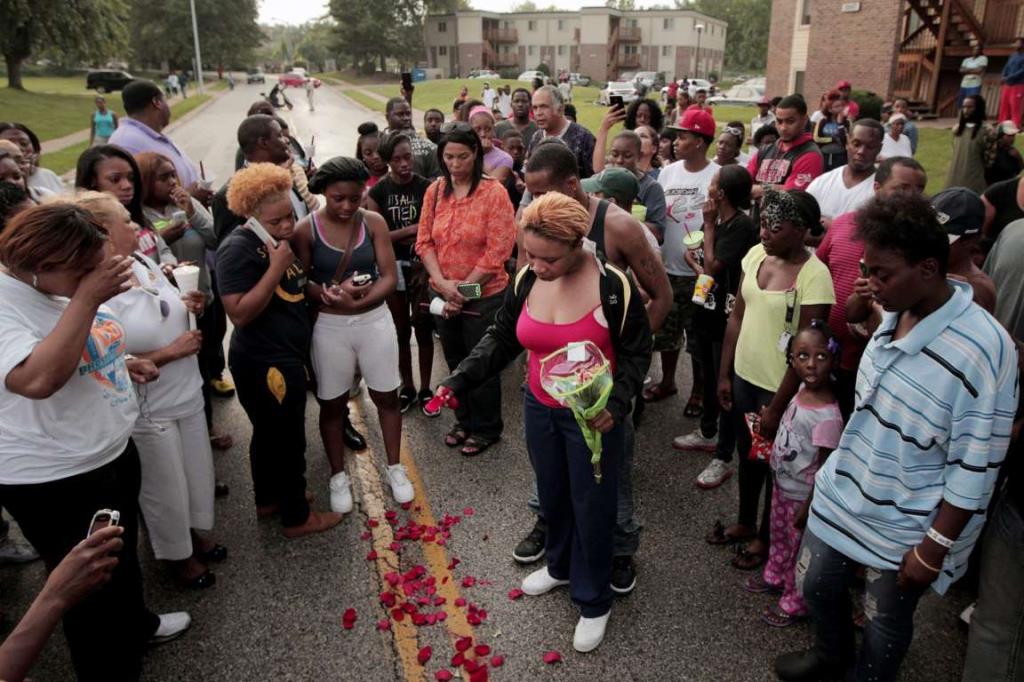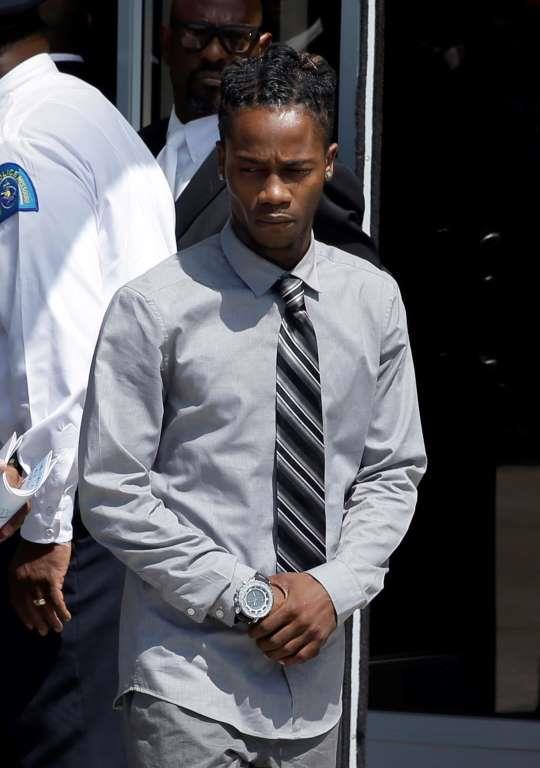November 26, 2014
November 26, 2014
FERGUSON, MO: The two friends' morning intersected by chance in the parking lot of the Canfield Green apartment complex. Dorian Johnson had been up since 7 a.m. on this overcast August Saturday and after getting dressed, he was ready for a smoke on any other morning a carefree ritual for easing into his day's routine in the St. Louis suburb of Ferguson.

In this Aug. 9, 2014, file photo, Lesley McSpadden, center, drops rose petals on the blood stains from her 18-year-old son Michael Brown who was shot and killed a police officer in Ferguson, Mo., Aug. 9. With a grand jury’s decision this week not to indict police officer, Darren Wilson for Brown’s killing, prosecutors released thousands of pages of testimony, interviews and documents that shine new and often harsh light on the events that unfolded in this suburb’s darkest hours.
Heading out in search of a cigarillo to roll some marijuana, Johnson spotted 18-year-old Michael Brown on the walkway threading the cluster of three-story brick buildings. "Big Mike" had just finished helping a woman get her children into a car. Now the two men, who'd met just a few months earlier, fell into easy conversation.
"When I told him I was going to get cigarillos, he was like 'I need one, too. Let's walk to the store,'" Johnson recalled. It was the most mundane of decisions, of seemingly little consequence. But in that moment, Brown set off down a path that by a few minutes past noon would lead to his death in a burst of police gunfire, and a conflagration that upended his community and challenged many Americans' conceptions of justice.
More than three months later, the world knows all about Ferguson, about the weeks of protests and rioting that followed the brief, but explosive encounter between a white police officer, Darren Wilson, and the black teenager, and the deep veins of mistrust it exposed. But with a grand jury's decision this week not to indict Wilson for Brown's killing, prosecutors released thousands of pages of testimony, interviews and documents that shine new and often harsh light on the events that unfolded in this suburb's darkest hours.
There are still parts of the story the public may never fully understand. Key facts about who did what remain clouded in conflicting narratives that nevertheless highlight a cascading series of poor choices. But the new information, taken together with what we already know, reveals lives and actions whose seeming ordinariness contrasts jarringly with the tragedy and turmoil unleashed when, by chance, they intertwined.
___
Brown and Johnson did not know each other all that well before the morning of August 9. The pair had met through a common friend a few months earlier, played videogames once in the 22-year-old Johnson's apartment and had traded occasional friendly conversation. But with time to spare that Saturday morning, they were both in the mood to be sociable.
Shortly before leaving the apartment complex, Brown — who'd recently taken to rapping about God —happened on a landscaper muttering angrily about a chain saw that wouldn't start. The teenager walked up to ask what was wrong. The man later told grand jurors that Brown "told me that the Lord Jesus Christ would help me with my anger problem."
Setting off on the half-mile walk to Ferguson Market & Liquor, Johnson and Brown — who was wearing a red St. Louis Cardinals' ball cap, shorts and a white t-shirt — found they had plenty to talk about, though their lives were separated by four years and significant experience.
Brown, born to teenage parents who never married, lived mostly with his grandmother, but recently he'd been staying with a friend in Canfield Green. Teachers at Normandy High School recalled him as a music lover who wrote his own songs and spoke of his gentle, joking manner. He was days away from starting classes at Vatterott College, a trade school, with hopes of becoming a heating and air conditioning technician. The first thing most people noticed about Brown was his size — 289 pounds and 6 foot 5 inches — "a little kid in a big body," gym teacher Charlie Kennedy recalled.
The slight-framed Johnson, his hair in dreadlocks, was four years older. He shared an apartment with his girlfriend and daughter, had briefly attended Lincoln University two hours away in Jefferson City, Missouri, and had recently lost his job.
"He was telling me he was going off to college… so I was telling him some of the challenges he was going to face," Johnson told the grand jury. "Basically our conversation was about future."
As they talked, the pair sauntered down residential Canfield Drive before turning left on West Florissant Avenue, the five-lane stretch of fast-food restaurants, discount stores and strip centers that is Ferguson's main drag. That put them into roughly the same area that Darren Wilson, a five-year veteran police officer, was assigned to patrol.
Wilson, 28, was a little more than a third of the way through a 12-hour shift. Like Brown, friends also described him as gentle and quiet. Wilson was a native of Texas whose parents divorced when he was young; his mother later was convicted of forgery. Wilson was divorced, too. But he found success in his work, winning a commendation last February for responding to a report of a suspicious vehicle, then struggling with the driver and detaining him for arrest until help arrived.
On this August Saturday, Wilson was patrolling Ferguson's sector 1 in his white marked Chevy Tahoe, outfitted in duty boots, navy cargo pants and a short-sleeve shirt bearing the department's insignia and his badge. He was carrying a gun. But despite being trained to use a Taser, he decided not to bring it because it was bulky and room in the front seat was tight.
At 11:29 a.m., he joined other officers in a brief, fruitless search for a man who reportedly threatened to kill a woman. Soon after, a dispatcher relayed a call for help with a 2-month-old baby who was having difficulty breathing.
"I'll be en route," Wilson responded. It was 11:47 a.m.
Minutes later, surveillance cameras show, Brown and Johnson walked into the convenience store, a beige brick box at the corner of Florissant and Ferguson Avenue.

In this Aug. 25, 2014, file photo, Dorian Johnson leaves Friendly Temple Missionary Baptist Church at the end of the funeral service for his friend, Michael Brown in St. Louis. Johnson was with Brown when he was shot and killed Aug. 9 by police officer Darren Wilson. With a grand jury’s decision this week not to indict police officer, Darren Wilson for Brown’s killing, prosecutors released thousands of pages of testimony, interviews and documents that shine new and often harsh light on the events that unfolded in this suburb’s darkest hours.
Johnson's testimony of what happened inside is backed up by the video. Brown went up to the counter and asked for Swisher Sweets, popular for making "blunts" — cigarillos hollowed out and filled with marijuana. He reached across the counter and grabbed a box, then reached again and grabbed a second handful. The clerk tried to slap his hand. Brown turned toward the door.
The clerk intercepted him. Brown shoved him away and told him to get back. As they left, the clerk said he was going to call the police.
"It shocked me a lot," Johnson said. "So I was asking him, I was like, you know, 'Hey, I don't do stuff like that. What's going on?'"
Brown just laughed it off and told him to relax, Johnson said.
"But in my head I'm like, I can't be calm. I can't be cool. Because I know what just happened, and we were on camera."
___
"We're taking a stealing in progress from 9101 West Florissant," Ferguson's police dispatcher radioed officers at 11:53 a.m. "It's gonna be a black male in a white T-shirt. He's running toward Quik Trip. He took a whole box of Swisher cigars." In fact, Johnson and Brown walked away from the store.
Wilson was still inside a home on nearby Glenark Avenue responding to the call for the sick baby. In the days after Brown was killed, police said Wilson did not know about the robbery until later. But in his testimony and interview with investigators, Wilson said he was aware that fellow officers were searching for a suspect.
A few minutes later, the dispatcher relayed more information: The suspect was wearing a red St. Louis Cardinals' hat, yellow socks and khaki shorts.
Finishing up with the sick call, Wilson radioed to fellow officers: "Do you guys need me?" He got no reply. But as he drove down Canfield toward Florissant, he spotted two men walking down the yellow center line. Johnson agrees that was the case, but that's where their accounts begin to diverge.
"I told 'em, 'Hey guys, why don't you walk on the sidewalk,'" Wilson told a St. Louis County police detective in an interview the day after the shooting.
But that's not what Johnson recalls.
"Get the f— on the sidewalk!" he testified the police officer told him and Brown.
Wilson began to drive away. But he said that when Brown cursed at him, he shifted into reverse and backed up, angling his SUV across traffic. Just before he did, he radioed in: "Put me on Canfield with two and send me another car."
According to Johnson, the officer shouted, "What did you say?" When Brown said something back, the officer opened his door, hard, into Brown's left side.
Wilson remembers it differently. "Hey, come here," he says he told the two men and started opening his car door. "What the f— are you going to do?" he says Brown responded, pushing the door closed.
Exactly what happened next is hard to discern, but Brown's arms and head ended up inside the SUV as the two began tussling, watched by drivers in cars that came to a stop in both lanes.
It was "just like some kind of tug of war or something was going on," said a witness who was watching from a nearby porch, and whose taped interview was played for the grand jury. (Grand jury transcripts redacted most witnesses' names.)
Watching from a few feet away, Johnson said he was paralyzed by shock.
"At the time I couldn't open my mouth, I couldn't speak. I wanted to say 'could someone calm down.'"
Wilson said Brown made a fist and punched him in the face.
"When I grabbed him, the only way I can describe it is I felt like a 5-year-old holding on to Hulk Hogan," the 210-pound officer testified. "I felt that another one of those punches in my face could knock me out or worse."
Inside the car, Wilson drew his gun — a .40 caliber Sig Sauer semi-automatic pistol loaded with jacketed hollow-point bullets. I said, "Get back or I'm going to shoot you."
"He immediately grabs my gun and says, 'You are too much of a pussy to shoot me,'" Wilson added.
The officer said he felt the gun twisting down on his hip, and "I thought I was getting shot."
Wilson squeezed off two shots — one hit the car door, the other struck Brown's hand from a distance of 6 to 9 inches, leaving blood that stained Wilson's pants leg and the interior driver's side door handle.
Johnson took off running and found shelter behind a car. Brown ran, not far behind, as the police officer exited his car.
Some witnesses say Wilson chased Brown, firing his gun as he ran. Others said the officer held his fire and yelled at Brown to stop. By nearly all accounts, the chase was brief. Brown stopped and turned to face the officer.
Wilson said Brown lowered his head and charged, pausing briefly when he was hit by the officer's fire, then kept coming. That account was backed up by some witnesses, while others saw things differently.
Brown's "hands were balled up. He has his arms bent towards his chest and he's running like, you know, almost like a tackle running," said one witness, who watched from the backseat of a minivan. "The officer was backing up as he kept coming closer to him and he didn't stop."
But other bystanders said Brown simply took a wobbly step or two toward the policeman, and never posed any real threat.
When Brown turned "he had the weirdest look on his face and he started coming forward. Not like he was going to attack him. It's like he's coming to him like to plea with him to stop," said another witness, who watched from the apartment complex. "The officer did say 'stop, stop, stop.' Well after that third time, he let loose. He kept firing. Until he hit the ground."
By the time Brown went down, Wilson testified, they were separated by just eight or ten feet, but witnesses gave varying estimates of the distance between them. Twelve discharged cartridge cases lay scattered across the scene.
Johnson stepped out from his hiding place behind the car and stared at the body of his friend, splayed across the pavement.
___
Later, investigators would conclude that Brown was felled just over 153 feet from Wilson's SUV, but that the officer was decidedly closer. Toxicology tests would show that the teenager tested positive for "a very significant dose" of marijuana. When investigators examined Brown's body on a morgue table, they found a small plastic bag of marijuana in his pocket, along with a cigarette lighter and two $5 bills. The words "Big Mike" were tattooed on his right forearm.
But on that Saturday afternoon, Brown's body lay for 4½ hours on the warm pavement, as the sergeant in charge of the scene tried in vain to reach one of his commanding officers and then waited for investigators from the St. Louis County Police to show up. Eventually, someone placed a sheet over the corpse.
Arriving on the scene a few minutes after the shooting, the sergeant testified that he found Wilson sitting behind the wheel of the Tahoe, staring at the dashboard, seemingly in shock.
"I had to shoot him," Wilson told him.
Ordinarily, the sergeant said, Wilson would have been instructed to wait at the scene until he could be formally interviewed. But as a crowd massed on the sidewalk and some became agitated, Wilson testified that he felt increasingly fearful about remaining in his car. The sergeant told him to leave and wait at the police station.
A mile away at the station, Wilson testified, he went into the bathroom and washed Brown's blood off of both his hands.
Then, "I went into our roll call room. I took my belt off. I took my gun out. I made it safe, and I sealed it an evidence envelope."
The investigation into the killing of Michael Brown had begun.
Courtesy: AP
















































































































